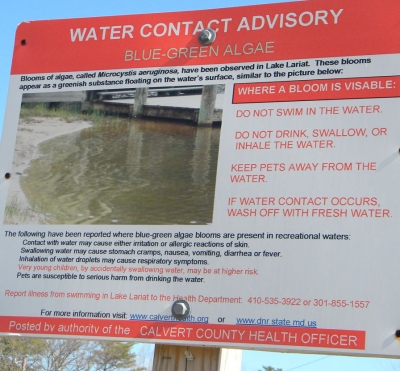Lake Lariat, in Lusby, Md., has been under a fish consumption advisory since 2002. According to Maryland Department of the Environment data from 2000 to 2010, the lake had the highest average levels of methylmercury, the most toxic form of the mercury, in the state over those 10 years. (Image: Google Maps)

John Bugno, 65, moved to Lusby about four months ago. He says he was not informed of the high mercury levels in Lake Lariat’s fish. (Photo: Madu Rajaraman)
Bugno, 65, a retiree, said he had not yet had a chance to check out the local recreation, but that he and his wife were considering buying a boat to use this summer. "My wife wants to go fishing," he said, adding that he may take his young grandchildren out with them.
Nestled within the lush wetlands of southern Maryland and home to the 86-acre Lake Lariat, Lusby seems to be a perfect spot for relaxation. Equestrian stables offer horseback riding. Boats sit eagerly in the driveways of homes surrounding the lake. Even in chilly March, Lusby appeared to anticipate a carefree summer.
"It's close to the bay, close to the water, and in the center of my four children," Bugno said.
But like many other lakes in Maryland, Lusby's Lake Lariat faces a public health hazard beneath the water's surface that may not be apparent to newcomers like Bugno: the presence of toxic mercury in its fish. Some complain that county and state health officials have not done enough to warn the community of dangers from consuming the tainted fish.
"I've heard that the lake is fine," Bugno said. "I see people fishing over there."
And that's a problem, said Susan Shaw, president of the Calvert County Board of County Commissioners. "People absolutely have a right to know" about the high mercury levels in fish, she said.
According to Maryland Department of the Environment data from 2000 to 2010, Lake Lariat's fish had the highest average levels of methylmercury, the most harmful form of mercury, in the state over those 10 years, with one sample testing at more than twice what the Food and Drug Administration considers the maximum amount safe for consumers.

Though Lake Lariat has a sign posted outside warning of algae blooms, nothing has been posted to warn the community of the dangers of eating fish caught in the lake. (Photo: Madu Rajaraman)
Despite being under an MDE fish consumption advisory since 2002, the Calvert County Health Department has not posted any signs warning residents of the dangers of eating fish caught in the lake.
There is a sign warning of algae blooms.
The current advisory, issued by MDE in 2007, recommends that adults consume no more than 12 meals a year of small or largemouth bass caught in Lake Lariat. Women of childbearing age are advised to consume no more than 10 meals a year, and it is advised that children avoid them altogether. Bass are more likely than smaller fish to contain high mercury concentrations, because they have had more time to ingest chemicals, both from the environment and from smaller fish.
According to the FDA, nearly all seafood contains traces of mercury. But when consumed often in methylmercury form, it can harm the developing nervous system of an unborn baby or young child, potentially resulting in decreased attention, memory and motor skills. This is why pregnant women and young children are the most vulnerable to mercury poisoning from fish. In adults, prolonged exposure may lead to the impairment of peripheral vision and muscle weakness, according to the Environmental Protection Agency.

Joyce Masano, 53, has lived in Lusby for 16 years and says she is displeased with the lack of information available to local residents about Lake Lariat. "I don't even swim in that lake," she says. (Photo: Madu Rajaraman)
Joyce Masano, 53, a Lusby resident for 16 years, said she wishes the county health department would take action to better inform the local community of the lake's condition.
"Fortunately for my family and myself, I became aware of environmental issues throughout college," said Masano, a stay-at-home grandmother. "But I'm not sure that a lot of people are aware of what mercury can do to pregnant women.
"I'm certainly not going to eat any of the fish in that lake," she added. "I don't even swim in that lake."
Paul McFaden, director of environmental health for the Calvert County Health Department, said local health officials would post a warning sign, similar to the algae warning, if they knew of a problem. Although MDE tests fish for contaminants annually, McFaden said he was not aware that Lake Lariat was under an advisory.
"We would post a sign just to make people aware," he said. "But I haven't heard" of the advisory.
Shaw said the health department knew of the problem and was supposed to take action.
"I was told that the health department was going to post a sign at least a year ago," Shaw said. "I think people would be very angry if they were fishing there and didn't know there was high mercury."
MDE spokesman Jay Apperson said he did not know whether the state department had explicitly informed the county health department about the consumption advisory. But, he said, there are other ways in which fish consumption advisories are communicated to the public, such as through the department's website, where the current document is posted within its "Marylander" section.
"Generally, they're targeted at women who are pregnant and have children," he said.
Officials say it is unclear what specific sources may be contributing to the lake's high levels of mercury, though generally, air emissions are to blame.
According to the EPA, coal-fired power plants are the leading source of mercury emissions in the country. Although plants do not emit methylmercury directly, the mercury emitted from these facilities can make its way into the food chain by settling in the waters of wetland environments, where it is then converted into the more toxic compound.
This map shows levels of methylmercury in fish from Maryland testing sites
between 2000 and 2010. Click on the colored dot to see mercury information for
an individual testing site. Red represents high mercury; yellow represents
moderate mercury; and green represents low mercury. Levels are shown in units of
nanograms of methylmercury per gram of fish tissue. Data provided by Maryland
Department of the Environment.
Link to full-size Map.
Google Earth users, click here to
download KML file. (Graphic: Madhu Rajaraman)
Though Lake Lariat is only about 34 miles from the Chalk Point Power Plant in Aquasco, Mark Castro, a professor at the University of Maryland Center for Environmental Science, cautions against assuming it is responsible for the high mercury levels in local fish.
Contamination could arise from any number of plants, not necessarily in Calvert County or even in Maryland, he said.
"You could have a lake right nearby, with nothing," said Castro, an associate professor in the center's Appalachian laboratory in Frostburg. "You can't pin it on the power plant."
Other sources of mercury pollution include municipal waste incinerators, cement plants, gold mines and crematories.
And Lusby's wetlands make it susceptible to methylmercury formation, he said.
On March 16, the EPA announced plans to implement a national standard for mercury emissions that would require coal-fired plants across the country to install pollution control technologies in their facilities. The proposed EPA rule would establish the first national standard for mercury emissions.
Maryland is one of 18 states with a mercury emission standard already in place, and it has seen improvements since the state's Healthy Air Act became effective in 2007, officials said. The law required coal-fired plants in the state to reduce mercury emissions by 80 percent by the end of 2010.
Tad Aburn, director of MDE's Air and Radiation Management Administration, said mercury emissions in Maryland plants have been reduced by 93 percent since 2007. "It's dramatically improved," he said.
But because air pollution crosses state boundaries, Aburn said he supported EPA's move to federally regulate mercury emissions.
"We're very supportive," he said. "A large chunk (of air pollution) comes from outside Maryland's borders."
Masano said she was glad MDE and EPA have taken steps to reduce emissions from coal-fired plants.
"They need to do something about the source, about the mercury," she said.
But Bugno, the newcomer to Lusby, said it would be a good idea for the health department to be more active in warning prospective and current residents of any potential dangers in local fishing.
"I would think they ought to do that," he said.
Why is Methylmercury a Concern?
According to the Food and Drug Administration, consuming fish has many nutritional benefits, such as proteins and omega-3 fatty acids, but almost all fish contain at least small traces of mercury. When eaten frequently as methylmercury, the most toxic form of the chemical, it can stay in the bloodstream and harm the developing nervous system of an unborn baby, which could lead to decreased attention, memory and motor skills. The FDA recommends that women who may be pregnant check their local fish advisories for information on whether recreationally caught fish is safe to eat. In adults, prolonged exposure may lead to the impairment of peripheral vision and muscle weakness, according to the EPA.
FDA and EPA Links:
http://www.fda.gov/.../Methylmercury/ucm115662.htm
http://www.epa.gov/hg/effects.htm
About the Data:
The Maryland Department of the Environment tests fish tissue for methylmercury each year from 153 sites in Maryland. The data used for this story and map consist of each site's recorded sample results for each year between 2000 and 2010. Maryland Newsline's Madhu Rajaraman analyzed it to calculate each site's average mercury level for the 10 years.
MDE Link of fish consumption advisories:
http://www.mde.state.md.us/.../fishandshellfish/
According to the Food and Drug Administration, consuming fish has many nutritional benefits, such as proteins and omega-3 fatty acids, but almost all fish contain at least small traces of mercury. When eaten frequently as methylmercury, the most toxic form of the chemical, it can stay in the bloodstream and harm the developing nervous system of an unborn baby, which could lead to decreased attention, memory and motor skills. The FDA recommends that women who may be pregnant check their local fish advisories for information on whether recreationally caught fish is safe to eat. In adults, prolonged exposure may lead to the impairment of peripheral vision and muscle weakness, according to the EPA.
FDA and EPA Links:
http://www.fda.gov/.../Methylmercury/ucm115662.htm
http://www.epa.gov/hg/effects.htm
About the Data:
The Maryland Department of the Environment tests fish tissue for methylmercury each year from 153 sites in Maryland. The data used for this story and map consist of each site's recorded sample results for each year between 2000 and 2010. Maryland Newsline's Madhu Rajaraman analyzed it to calculate each site's average mercury level for the 10 years.
MDE Link of fish consumption advisories:
http://www.mde.state.md.us/.../fishandshellfish/


